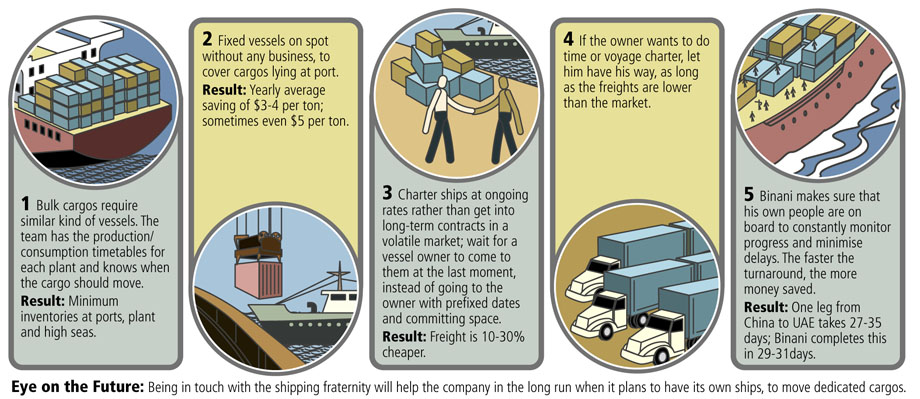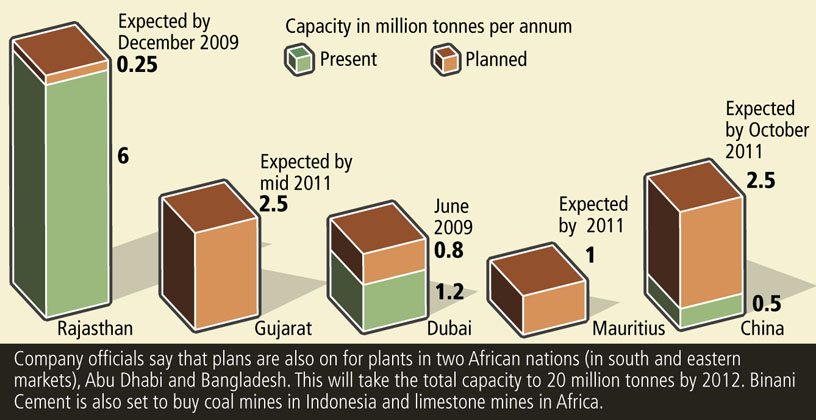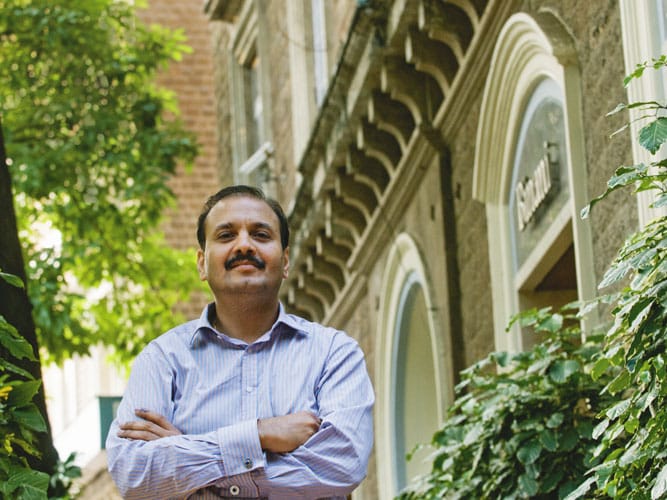Why is Braj Binani travelling in the opposite direction?
All the world is coming to India’s fast-growing market, but the cement maker is heading out of India
Driving down the wide roads of Ballard Estate — Mumbai’s earliest business district famous for its buildings with European Renaissance facade and canopy trees — it is easy to miss the corporate office of Binani Cement along one of the inner lanes. Visitors are more likely to notice the nearby Reliance Centre that now belongs to Anil Ambani’s ADAG Group or the headquarters of engineering giant Larsen & Toubro. Ironically, both have been linked to the cement industry: ADAG has announced a multi-
billion dollar plan to set up cement plants in India, while L&T made an exit from the business five years ago even after creating a brand that was on top of its game.
Binani Cement is the perfect antithesis to its two big India Inc. peers. Over the last 12 years of its history, few have followed its progress. Braj Binani, its extremely low-key founder, has kept the company free of any ambition to challenge the might of industry majors like ACC or Grasim. The company has been doing just enough to be in the middle of the pack of cement makers. Even its initial share issue three years ago in the middle of a bull run only managed a muted response. In fact, the only time it made the bold headlines in pink papers was when Anil Ambani was rumoured to have offered to buy out Binani’s promoter, something denied by the latter.
“I didn’t get any offer from Reliance but many foreign companies were interested,” Braj Binani says matter of factly. The 49-year-old Marwari businessman looks relaxed at his office, sitting in the company of his two daughters, Nidhi and Shradha; and seemingly oblivious of the harsh realities that his corporate neighbours reflect of the Indian cement industry — even the top players have bowed out and new competition is emerging from international and domestic companies with deep pockets.
Instead, he is focussing on building his cement empire on a model that is alien to the Indian concrete industry — Binani Cement is perhaps the only true-blood cement maker from India that is focussing on global markets. Apart from its lone Indian plant in Rajasthan, the company has over the years added operations in West Asia, China and Mauritius. Most of its future investments will be to add capacity internationally. Binani says this includes setting up or acquiring plants in Turkey, Abu Dhabi, at least two African nations and Bangladesh. The investment in Turkey alone might be worth Rs. 1,000 crore. Also on the cards is the acquisition of coal mines in Indonesia. While officially, Binani plans to increase capacity to 15 million tonnes a year by 2012 from the present 8 million tonnes, insiders say that the actual road map envisages an annual capacity of 20 million tonnes within the same deadline. More than half of this capacity will come from facilities outside India. Investment in India will be restricted to the new integrated plant in Gujarat and two small clinkers in the eastern part of the country.
“Over time, half our revenue will come from global markets,” says Binani. Why on earth would Binani want to go abroad when there is plenty of demand in the domestic market? Binani’s answer is clear. “Where is the land for setting up a new plant? The limestone supplies are limited as of now and logistics cost in in India is too high,” he says.
The Cost Game
Central to Binani’s international strategy is the management of costs, especially in the movement of cement. The highest cost component for cement is tax, accounting for 40 percent of the cost per bag. But companies can still make a difference by bringing down their power, raw material and logistics costs. Though it needs to import coal, Binani has a captive power plant and its own limestone mines in Rajasthan, helping it to trim costs. But the key differential has been its logistics cost, which hovers around the lower band of the industry average that varies from 17 to 22 percent of the total production cost. One of Binani’s most innovative initiatives in this has been to convince Indian Railways to allow it to use the empty wagons that go back to ports in West India after delivering their cargo. This helps Binani save a fifth of the normal railway freight cost.
The initiatives seem to have paid off. Binani Cement’s core profit margin, which had dropped to 21 percent last year, has increased to 34 percent in the first six months of the present financial year. There are two reasons: First, coal prices have come down from last year’s level and second, lowering of costs has helped, says analyst Vineet Agarwal of SKP Securities.
Binani has extended this low-cost strategy internationally. The plants in Dubai, China and Mauritius are all close to ports, thus saving on transport costs. In China, cheap land, labour, power and captive limestone mines mean that production costs are “much lower” than in India. More importantly, Binani has not designed his international plants as islands, but as satellites depending on each other.
This is part of Binani’s “international hedging strategy”, where each unit will feed the other. The Mauritius plant will feed the African markets; the soon-to-be bought manufacturing units and limestone mines in Africa will supply raw material to the plant. China, where Binani has limestone and clinker, will feed the planned facility in Bangladesh. It is already shipping to Dubai. “We bought China’s Shandong Rongan Group Co in 2006 with two objectives,” points out Binani. “One, Chinese market was the biggest and second, cost of production was so low that clinker was $7 per tonne cheaper than in India and would cover the $5 per tonne freight cost for exporting it to our Dubai plant.”
But Binani’s international network is getting to be complex. He plans to take coal from Indonesia and export it to China and India. The African markets will be supplied from the units in Mauritius and West Asia. He needs to integrate all this without compromising on his low-cost advantage. Sensing the need, Binani recently set up an office in Singapore, the hub for shipping companies in the region. Headed by cousin Shyam Binani, that office has mastered the game of international chartering that keeps freight charges up to 30 percent lower than its competitors’ and also cuts down on the travel time.
Already a fourth of Binani Cement’s revenue comes from its international operations. By 2012, the share will double to make up half of Binani Cement’s revenue, says Vinod Juneja, managing director. During this period, the company aims to grow by 25-30 percent per year.
Surprisingly, the business model has not cut ice with Binani Cement’s peers and not many have taken it seriously. It might be because of the scale that Braj Binani is attempting through his unique model. Even at 20 million tonnes, Binani Cement’ total capacity will be less than half that of the present market leader Grasim (after group company Ultratech is merged with it). For many, it is tough to understand why an Indian cement maker would want to enter international markets when the domestic market is the second fastest growing market in the world after China.
From the Start
For the Binani family, international exposure came early, back in the 1950s when Braj’s grandfather set up offices in London and later in West Asia for international trading in non-ferrous metals like copper. Even in its first major manufacturing foray, which was to set up a zinc plant in Kerala, the family roped in an international player in Canada’s Cominco. Thus, resorting to the international market was natural for the young Braj Binani, especially when the family’s latest diversification in cement, in the late 90s, “was born in losses.”
Recounts Binani: “As soon as we commissioned the plant in Rajasthan, the economy went bust. We had invested Rs. 400 crore in the new project and the interest payments were high. Other businesses, zinc and glass fibre, were also not doing that great.” But it was easier and cheaper to raise money in foreign currency and the Binanis decided to implement an early lesson from their international business — hedging operations across various markets to limit losses. The age-old connections in Dubai helped the Indian business family get a strip of land near the port. The location would prove crucial later when local construction industry boomed in the mid-2000s. The cost of production was low, thanks to the region’s considerable energy resource making power cheap.
The international strategy would pay for Binani, at least in the next three years, as the domestic market in India suffers from a supply glut. Says Sanjay Ladiwala, president of Cement Stockists & Dealers Association of Mumbai: “Almost 30 million tonnes of cement capacity is being added in India every year. Even if the cement demand is to grow by 9 percent, there would be an excess capacity of about 7 million tonnes annually for another three years.” This ultimately means weaker cement prices in the local market.
Industry veterans are not convinced. Anil Singhvi, former managing director of Gujarat Ambuja and now the head of Reliance-ADAG’s cement foray, contends that cement is not a short-term game to be looked through a three- or five-year prism. “Look at the infrastructure development that is needed in India. New capacities will stop coming up after a few years and in the long run, demand will outstrip supply in the Indian market,” he says. Adds an executive from another major cement company in India, “Normally you hedge your product in different kinds of markets. But Binani is setting up facilities in similar, emerging markets. The growth might be fast but the risks are higher.”
One key risk is that Binani Cement isn’t a huge player in its home market. Most companies like Cemex or Lafarge expanded internationally after they had become large players in their home market. This is important because if something goes wrong with the international game-plan, there is a domestic business cash-flow to fall back on. The second major risk is that the international supply chain that the company has developed, looks merely opportunistic. There is no telling how it will fare once the demand for ships goes up in a better global economy. All the cost advantage could very well get eroded.
Moreover, building an international business would need management bandwidth and expertise in human resource. Dipesh Dipu, principal consultant at PricewaterhouseCoopers, says that while foreign ventures may be driven from the geographical diversification perspective, “political and legal risks” are key in foreign ventures. “These range from uncertainty in regulatory framework to concerns about nationalisation…There are also concerns of social engagements with people of different cultures and managing such soft keys may be challenging at times.”

So does Binani Cement, a family-owned business, have enough know-how to face the challenges? Sensing these doubts, Braj Binani is rejigging the management structure of Binani Industries, the group holding company that owns 65 percent of the shares in the cement subsidiary. He has appointed managing directors for each of the three companies, including Binani Cement’s Juneja, who joined two years ago. Earlier this year, Binani roped in Sunil Sethy, a KK Birla Group veteran, as the managing director of the holding company. “Earlier, everyone used to report to Mr. Binani. Now we have put in place a corporate structure so that the responsibilities are delegated…we are also creating a second line at every level to identify the next crop of leaders,” says Sethy.
The initiatives, Binani believes, will transform the group from a “family-owned to a family-driven enterprise.” Insiders say, the move is aimed more at international investors. “He wants to prove that Binani Cement and Binani Industries are professionally run organisations,” says a company executive. Surely, Binani wants his company to be taken seriously, maybe not domestically, but surely globally.
(This story appears in the 20 November, 2009 issue of Forbes India. To visit our Archives, click here.)















